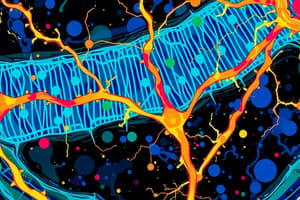Podcast
Questions and Answers
What is the effect of a non-competitive antagonist on agonist efficacy?
What is the effect of a non-competitive antagonist on agonist efficacy?
- Reduces both potency and efficacy of the agonist (correct)
- Increases the efficacy of the agonist
- Increases the potency of the agonist
- Allows full agonist effect regardless of concentration
How does a competitive antagonist affect the potency of an agonist?
How does a competitive antagonist affect the potency of an agonist?
- It enhances the potency of the agonist
- It completely inhibits the agonist's effect
- It has no effect on the potency of the agonist
- It reduces the potency requiring higher agonist levels (correct)
In the presence of a competitive antagonist like esmolol, what is required to achieve a significant effect on heart rate?
In the presence of a competitive antagonist like esmolol, what is required to achieve a significant effect on heart rate?
- Increase in esmolol dosage
- Higher levels of catecholamines like norepinephrine (correct)
- Complete removal of the antagonist from the system
- Decrease in catecholamine levels
What happens to the response of an agonist if a non-competitive antagonist occupies the receptor?
What happens to the response of an agonist if a non-competitive antagonist occupies the receptor?
When catecholamines are administered, what is their primary role in the body?
When catecholamines are administered, what is their primary role in the body?
What type of molecular bond is associated with phenoxybenzamine?
What type of molecular bond is associated with phenoxybenzamine?
What is the effect of phenoxybenzamine binding to an alpha receptor?
What is the effect of phenoxybenzamine binding to an alpha receptor?
Why is phenoxybenzamine not commonly used today?
Why is phenoxybenzamine not commonly used today?
Which drug interaction is particularly enhanced by covalent bonding?
Which drug interaction is particularly enhanced by covalent bonding?
What is a potential downside of the long-lasting effects of phenoxybenzamine?
What is a potential downside of the long-lasting effects of phenoxybenzamine?
In the context of drug interactions, what does non-competitive mean?
In the context of drug interactions, what does non-competitive mean?
What is the main utilization of covalent bonding in some therapeutics, such as aspirin?
What is the main utilization of covalent bonding in some therapeutics, such as aspirin?
What is a major concern with non-competitive drugs in terms of their clinical effect?
What is a major concern with non-competitive drugs in terms of their clinical effect?
Which type of bonding is typically not the strongest in the context of receptor interactions?
Which type of bonding is typically not the strongest in the context of receptor interactions?
What does chirality in molecules refer to?
What does chirality in molecules refer to?
What influence does stereochemistry have on molecules in the body?
What influence does stereochemistry have on molecules in the body?
Why is it generally undesirable for a drug to form irreversible bonds?
Why is it generally undesirable for a drug to form irreversible bonds?
Which of the following concepts is most closely associated with enantiomers?
Which of the following concepts is most closely associated with enantiomers?
What type of drugs has become commonly used, as mentioned in the discussion?
What type of drugs has become commonly used, as mentioned in the discussion?
In molecular bonding, which interactions are generally considered stronger?
In molecular bonding, which interactions are generally considered stronger?
What is a common misconception about binding strength in receptor interactions?
What is a common misconception about binding strength in receptor interactions?
What is a racemic mixture?
What is a racemic mixture?
Which isomer of ketamine is preferred for its desired effects?
Which isomer of ketamine is preferred for its desired effects?
What side effect is commonly associated with R-ketamine?
What side effect is commonly associated with R-ketamine?
Which formulation of bupivacaine is less cardiotoxic?
Which formulation of bupivacaine is less cardiotoxic?
What do the terms 'S' and 'R' represent in isomer nomenclature?
What do the terms 'S' and 'R' represent in isomer nomenclature?
What is a potential consequence of administering too much of the standard bupivacaine?
What is a potential consequence of administering too much of the standard bupivacaine?
In some countries, what has been developed for the ketamine formulation?
In some countries, what has been developed for the ketamine formulation?
Which of the following best describes the effect of esketamine?
Which of the following best describes the effect of esketamine?
Why is ketamine often provided as a racemic mixture?
Why is ketamine often provided as a racemic mixture?
What is the main advantage of using S-ketamine over the racemic mixture?
What is the main advantage of using S-ketamine over the racemic mixture?
What is the main effect of a full agonist on receptors?
What is the main effect of a full agonist on receptors?
What type of drug is buprenorphine categorized as?
What type of drug is buprenorphine categorized as?
What happens to receptor activity with continuous administration of an agonist?
What happens to receptor activity with continuous administration of an agonist?
What is typically observed with partial agonists in relation to their efficacy?
What is typically observed with partial agonists in relation to their efficacy?
In the context of anesthesia, what does anxiolysis refer to?
In the context of anesthesia, what does anxiolysis refer to?
What is a potential consequence of a patient on buprenorphine undergoing surgery without discontinuing the medication?
What is a potential consequence of a patient on buprenorphine undergoing surgery without discontinuing the medication?
Which of the following is an example of a full agonist used in anesthesia?
Which of the following is an example of a full agonist used in anesthesia?
What is the main characteristic of partial agonists that distinguishes them from full agonists?
What is the main characteristic of partial agonists that distinguishes them from full agonists?
What is the primary function of GABA receptors in the context of anesthesia?
What is the primary function of GABA receptors in the context of anesthesia?
Which statement about full and partial agonists is true?
Which statement about full and partial agonists is true?
Flashcards
Covalent Bonding in Drug-Receptor Interactions
Covalent Bonding in Drug-Receptor Interactions
A type of drug-receptor interaction where the drug binds to the receptor through a strong covalent bond, resulting in a long-lasting effect.
Phenoxybenzamine
Phenoxybenzamine
A drug that forms a covalent bond with its receptor, resulting in a prolonged effect that can last for days.
Alpha Blocker
Alpha Blocker
A drug that binds to a receptor and blocks its activity, preventing other molecules from binding.
Duration of Action
Duration of Action
Signup and view all the flashcards
Drug Elimination
Drug Elimination
Signup and view all the flashcards
Prolonged Effect (Advantage)
Prolonged Effect (Advantage)
Signup and view all the flashcards
Prolonged Effect (Disadvantage)
Prolonged Effect (Disadvantage)
Signup and view all the flashcards
Non-Competitive Antagonism
Non-Competitive Antagonism
Signup and view all the flashcards
Competitive Antagonism
Competitive Antagonism
Signup and view all the flashcards
Potency
Potency
Signup and view all the flashcards
Efficacy
Efficacy
Signup and view all the flashcards
Full Agonist
Full Agonist
Signup and view all the flashcards
Non-competitive Inhibition
Non-competitive Inhibition
Signup and view all the flashcards
Covalent Bonding in Drug Interactions
Covalent Bonding in Drug Interactions
Signup and view all the flashcards
Ionic Bonding vs. Dipole-Dipole Interactions
Ionic Bonding vs. Dipole-Dipole Interactions
Signup and view all the flashcards
Stereochemistry in Drug Interactions
Stereochemistry in Drug Interactions
Signup and view all the flashcards
Chirality and Enantiomers
Chirality and Enantiomers
Signup and view all the flashcards
Chirality of Drugs
Chirality of Drugs
Signup and view all the flashcards
Stereochemistry and Receptor Binding
Stereochemistry and Receptor Binding
Signup and view all the flashcards
Chirality of Biological Molecules
Chirality of Biological Molecules
Signup and view all the flashcards
Signup and view all the flashcards
Racemic Mixture
Racemic Mixture
Signup and view all the flashcards
Enantiomer
Enantiomer
Signup and view all the flashcards
S-Ketamine
S-Ketamine
Signup and view all the flashcards
R-Ketamine
R-Ketamine
Signup and view all the flashcards
Ketamine
Ketamine
Signup and view all the flashcards
Levobupivacaine
Levobupivacaine
Signup and view all the flashcards
Arbupivacaine
Arbupivacaine
Signup and view all the flashcards
Chiral Rotation
Chiral Rotation
Signup and view all the flashcards
Chiral Resolution
Chiral Resolution
Signup and view all the flashcards
Esketamine
Esketamine
Signup and view all the flashcards
Drug Effect Spectrum
Drug Effect Spectrum
Signup and view all the flashcards
Downregulation
Downregulation
Signup and view all the flashcards
Partial Agonist
Partial Agonist
Signup and view all the flashcards
Antagonist
Antagonist
Signup and view all the flashcards
Mixed Agonist-Antagonist
Mixed Agonist-Antagonist
Signup and view all the flashcards
Ceiling Effect
Ceiling Effect
Signup and view all the flashcards
Withdrawal Symptoms
Withdrawal Symptoms
Signup and view all the flashcards
Buprenorphine
Buprenorphine
Signup and view all the flashcards
Partial Agonist Effects During Procedures
Partial Agonist Effects During Procedures
Signup and view all the flashcards
Study Notes
WEBVTT Summary
- Potassium channels are slower than sodium channels
- Potassium channels cause repolarization, moving potassium out of the cell
- Sodium channels cause depolarization, flooding the cell with sodium
- Overshoot of resting membrane potential happens because potassium exits the cell more slowly than it enters
- Hyperpolarization occurs when the membrane becomes more negative than its baseline potential
- Sodium-potassium pump restores homeostasis by pumping sodium out and potassium in
- Sodium channels have a different conformation in the inactive state, preventing sodium from entering the cell
- Configuration of sodium channels can change over time
Studying That Suits You
Use AI to generate personalized quizzes and flashcards to suit your learning preferences.
Related Documents
Description
Explore the critical roles of potassium and sodium channels in neuronal activity. This quiz covers the processes of depolarization, repolarization, hyperpolarization, and how the sodium-potassium pump maintains membrane potential. Test your understanding of these fundamental concepts in neuroscience.





